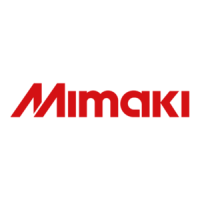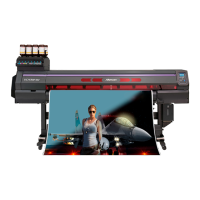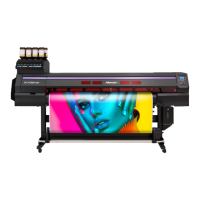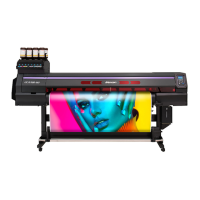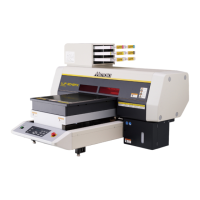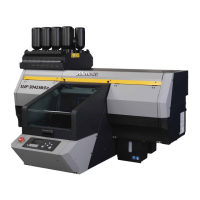How to clear clogged nozzles on my MIMAKI UCJV300-130?
- TTravis RobertsAug 17, 2025
To clear clogged nozzles, you can try the following: * Perform head cleaning. * Perform print head nozzle washing. * Perform [MENU] > [Maintenance] > [INK FILL].
How to clear clogged nozzles on my MIMAKI UCJV300-130?
To clear clogged nozzles, you can try the following: * Perform head cleaning. * Perform print head nozzle washing. * Perform [MENU] > [Maintenance] > [INK FILL].
What to do if the ink has leaked from my MIMAKI Printer?
If an ink leak occurs, immediately turn off the main power and unplug the power cable. Then, contact your local dealer or our service office.
What to do if the light-blocking cover comes off my MIMAKI Printer?
If the light-blocking cover comes loose, reattach it by following these steps: 1. Insert the lug on one side of the light-blocking cover into the corresponding hole in the tank. 2. Insert the lug on the other side while pushing in toward the first hole.
Why does the media jam or get dirty in my MIMAKI Printer?
To address media jams or dirty media, consider the following: * Ensure you are using the recommended media. * Avoid using curled media or media with folded ends. * Use the take-up unit to adjust or reload the media.
How to fix image defects occurring on my MIMAKI Printer?
To address image defects, try the following: * Remove any paper scraps or debris from areas the head passes over, such as media holders. * Perform head cleaning. * Perform feed correction. * Clean the wiper. * Clean the cap rubber. * Clean the carriage underside.
How to correct misaligned print and cut positions on my MIMAKI UCJV300-130 Printer?
If the print and cut positions are misaligned, use the MIMAKI RIP software (RasterLink) to print a correction pattern. Then, check the pattern and manually input correction values.
Why does the cut position shift on my MIMAKI UCJV300-130?
If the cut position shifts, it may indicate a problem with the register mark sensor. Perform the operation used to check the responsiveness of the register mark sensor. Note that you cannot check the responsiveness manually.
How to troubleshoot a MIMAKI UCJV300-130 Printer when the power does not turn on?
To resolve the issue of the power not turning on, ensure the power plug is securely inserted into the power outlet, use the power cable provided, and turn on the main power.
What to do if the MIMAKI UCJV300-130 power does not turn on?
If the MIMAKI Printer does not turn on, ensure the power plug is securely connected to the power outlet. Also, make sure you are using the power cable provided with the printer and that the main power is turned on.
How to fix image defects on MIMAKI Printer?
To fix image defects on your MIMAKI Printer, remove any paper scraps or debris from areas where the head passes, such as media holders. You may also need to perform head cleaning, feed correction, wiper cleaning, cap cleaning, and carriage underside cleaning. Additionally, consider performing an ink fill, replacing the wiper, or registering nozzle recovery.
Details precautions for safe operation, including handling abnormal conditions and power supply.
Identifies and describes the main parts of the printer, including front, rear, and side views.
Explains the functions of the display, keys, and status lamp on the operating panel.
Details power connection, turning the machine on/off, and PC connectivity via USB/LAN.
Guides on driver setup, RIP software installation, and color profile acquisition.
Provides instructions for replacing ink bottles and managing ink levels.
Step-by-step guide to the printing process, from powering on to cutting media.
Guides on replacing consumable parts like wipers, cap absorbers, filters, cutters, and waste ink tanks.
Explains warning, ink, and system error messages with their causes and corrective actions.
Detailed technical specifications for printing features, ink sets, media, and environment.
| Print Resolution | 1200 x 1200 dpi |
|---|---|
| Ink Colors | CMYK + White + Clear |
| Connectivity | USB 2.0, Ethernet |
| Ink Type | UV curable ink |
| Media Types | Vinyl, paper |
| Media Thickness | Up to 1 mm (0.04 in) |
| Roll Weight | Up to 40 kg |
| Power Requirements | AC 200-240V, 50/60Hz |
| Print Technology | UV-LED Inkjet |
